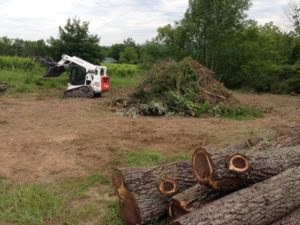Solar Energy System Fully Operational
January 20, 2016– Our 28kW solar system has been operational since October 23, 2015. The system consists of 108 panels in three arrays and is installed on a south-facing slope at our farm. It was designed and installed by QwikSolar of Geneva, NY. Despite the short days we experience at this time of year, the system has generated 4,460 kilowatts of energy in its first three months. This equates to 2.36 tons of carbon dioxide that was not emitted by a power plant during that time, or the planting of 61 trees (which suck carbon out of the atmosphere).
The system is designed to generate 100% of the winery’s electricity needs over the course of a year. This typically means we generate extra power that is sold back to the utility company during the summer months, and supplement the power we generate with electricity purchased from the grid during the winter. Due to the unusually sunny November weather, however, we have had negative utility bills since the system went live! We’re generating more than we are using even during the winter! Stay tuned… we hope to soon be able to share our energy production in real time on our web site.

Last summer, trees were cleared on a south-facing slope for the new solar array. The wood will be used for new trim in the tasting room.
Energy Efficiency Combined + Renewables = Success
The key to our energy-saving success is energy-efficiency. Our winery/tasting room building and warehouse building were both incredibly energy efficient before we switched to solar. Both buildings are very well insulated, and are heated and cooled by energy-sipping air-source heat pumps. We have a well-insulated hot water heater and a highly efficient glycol chilling system in the winery. All of our lighting is compact fluorescent or LED. We only use electric power (no propone or natural gas). We were able, therefore, to install a relatively small system to supply 100% of our energy needs. Larger businesses or those that consume lots of energy by way of inefficient equipment or drafty buildings would need a much larger solar system (that would be prohibitively expensive), and would probably still need to supplement with fossil-fuel-based energy sources.
Saving Energy Means Saving Money… Eventually
A consultant took a little bit of wind out of our sails during the design & planning process of our solar project by pointing out that “these systems don’t really save you money.” His point was that the cost of the system (even with the beneficial grant and financing programs now available) equals or exceeds the lower or non-existent utility bills. This is true during the time you are paying for the system. However, the systems are warrantied for at least a decade after being paid off, and will most likely last longer. At that point, the energy generated is “free” so we will save a lot of money in the long-run. And for us, the idea of knowing that we are doing right by planet Earth during the payoff period (spending our money on solar panels instead of a coal-burning power plant) has a lot of value.
Overall Carbon Footprint of Our Business
Our solar energy system greatly reduces the carbon footprint of Silver Thread by almost completely eliminating our use of fossil fuels. Our only fossil-fuel use at this time is our vineyard tractor, although it is one of the most fuel-efficient models we can buy. Stay tuned, though, as we have a pipe dream of electrifying the tractor (retrofitting the engine with a battery that can be charged by the solar panels)!
Since our vines are perennial and require minimal tillage, very little carbon dioxide is released through our farming practices. While fermentation creates carbon dioxide, the amount we produce is more than offset by the uptake of carbon by the green growth on our vines during the growing season. We use lightweight glass bottles for our wine, which reduces the energy needed to produce them and transport them. We also use corks made from cork bark, a renewable resource.
The overwhelming majority of our wine is sold regionally (directly from our tasting room or within the northeastern US), which minimizes carbon emissions from transportation. We purchase carbon offsets from UPS for every order of Silver Thread wine that is shipped direct to consumers.
We are constantly analyzing every aspect of our business to ensure we are doing what is the most economically and environmentally prudent for the planet, our employees and our customers. We’d love to hear your thoughts and suggestions in this area!
A Regional Movement Toward Renewable Energy
Many Finger Lakes wineries have been investing in solar and wind energy over the past few years due to generous grant, financing and tax credit programs enacted by New York State and the Federal Government. Silver Thread’s system was made financially attractive by a grant and low-interest financing from NYSERDA (New York State Energy Research Development Authority). Various environmental threats facing the Finger Lakes region, including proposed expansion of LPG (liquefied petroleum gas) storage in salt caverns under Seneca Lake and hydro-fracking just across the border in Pennsylvania, have added urgency to the need to turn away from fossil fuels, especially propane and natural gas. Tourism-based businesses (including Silver Thread) have banded together to fight against environmental degradation of the region by forming the Finger Lakes Wine Business Coalition. As a lover of the Finger Lakes, please join us in educating yourself about the issues facing our region and support us in this critical effort.


